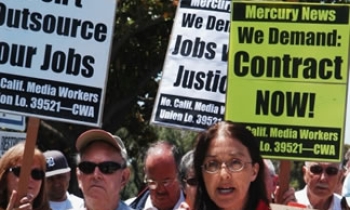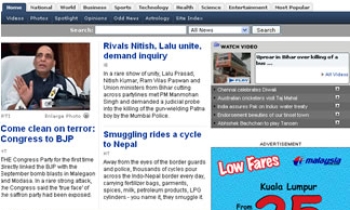THE Houston Chronicle's headline read: "Bells ring out for 12 rescued miners." It was an appropriately triumphant tout that 12 of the 13 men who had been trapped for 41 hours in a West Virginia coal mine would soon be going home to their worried families.
Unfortunately, the headline and The New York Times story we published Wednesday on Page One were wrong, as we and other news media outlets subsequently learned. The damage, however, had been done. An inaccurate story had made it into the newspaper. That is never acceptable.
But if there is such a thing as a pardonable news media sin, this story offers the example. Granting a pardon, however, requires readers to appreciate the circumstances surrounding this story.
Ideally, if news about the trapped miners being rescued alive had begun circulating Tuesday morning, we likely would not be engaging in this discussion.
The reporter at the scene would have remained optimistically skeptical about initial reports of their rescue, but more importantly, would have gone through the logical progressions of verifying the information and its source.
But reality bites. Word about the miners' rescue began circulating about 11 p.m. our time, perilously close to when the last Chronicle editor leaves around 1 a.m. each morning. The early edition of the Chronicle reported that one miner had been found dead. Then the story changed.
"When the initial, erroneous, news broke that 12 miners were alive, we changed the front page between editions," said Chronicle managing editor John Wilburn. "Three hours later, around 2 a.m. (CDT) when the correction info moved, the press run was almost complete and the newsroom had all gone home. It was too late to change the story." Chron.com was one of the first Web sites in the country to post a corrected, updated version of the story.
Still, readers may ask: "Why did the news media have to go with an inaccurate story at all?" That is a fair question that presumes that reporters knew the information that was coming from family members, friends, an official with the West Virginia Department of Military Affairs and Public Safety and the governor was false.
Going with a secondhand source on deadline can be a risky proposition, explained Tom Rosenstiel, director of the Washington-based Project for Excellence in Journalism and co-author of Elements of Journalism.
"I think that when you're not sure about something, but you've got to go with the best you've got, that's when we should be as circumspect as possible," Rosenstiel said. "The way to do that is to be as clear as possible with the public about what we have and what we don't have and what the sourcing is."
But this was not a situation in which a reporter's radar would necessarily be fully engaged, Rosenstiel said.
"Under the circumstances, it's hard to imagine that reporters at the scene would be skeptical," he said. "On the other hand, that is what we are supposed to do. So the best protection is to not pretend to more knowledge than you actually have.
"Could this have been done better? I think so," Rosenstiel continued. "But is the mistake understandable? Absolutely, and in fact, it would have taken a really vigilant reporter who was probably not as exhausted or caught up emotionally in this – as a normal human being would be – to keep your head." Rosenstiel noted that it would be useful for the public and the press to make a distinction between errors of commission and errors of omission.
"There's a big difference between plagiarism or fabrication and something like this," he said. "And the fact that journalists all over the country are spending so much time reflecting on something like this, frankly shows how much we really do worry about how we do what we do."
While this story may be a forgivable sin, it is yet another hit to journalism's credibility and further decays the public's trust of information we provide. Rosenstiel said regaining readers' trust means raising the transparency bar.
"We are in a different era," he said. "We've gone from an era of what I call 'trust me journalism' to the era of 'show me journalism'. We can't pretend to perfection because everybody with a Web site has become a real-time critic of the press."
Campbell is the Chronicle's Readers' Representative and a member of the Editorial Board (james.campbell@chron.com).









